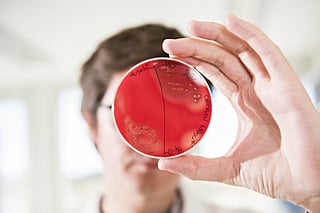
WeAreAquaculture spoke with Dr. Kyla Zatti, head of BioMar’s study showing that complete substitution of fish oil with algae oil not only has no detrimental effects on salmon performance but also benefits human health and the environment.
Nofima researcher Elisabeth Ytteborg is researching how warmer oceans affect cod farming - and says rising seawater temperatures around Norway puts its future farmed fish at risk.
Early detection of sea lice could soon become a reality, as researchers trial a new technique using holographic cameras. The technology, developed by a team of Scottish researchers, brings together holographic 3D imaging, machine learning and artificial intelligence, to detect whether sea lice larvae are present in sea water.
Meanwhile, Norwegian salmon farming giant Cermaq announced it is rolling out laser technology to treat salmon lice at some of its facilities in Nordland and Finnmark.
Biotech startup MicroHarvest recently launched a cutting-edge pilot plant in Lisbon that will enable the company to accelerate the path to commercialization of its single-cell protein ingredients.
WeAreAquaculture spoke to Hans Bjelland, Director of EXPOSED, SINTEF's Center for research and innovation on sustainable offshore seafood production, to find out about the future of offshore and exposed aquaculture.
A new study by researchers at Australia's Murdoch University revealed that exercise regimes can help fish of all species to reach marketable sizes at an accelerated rate, boosting production efficiency for aquaculture operations. The findings showed that fish that had been exercised by manipulating water currents grew around 10% quicker than fish kept in still water.
A German consortium including land-based shrimp farmer Oceanloop achieves 95% accuracy in monitoring and detection of growth, size, mortality and stress of shrimp in land-based aquaculture.
A Scottish spin-out trials novel chemical-free approach to treating aquaculture waste with Scottish Sea Farms, growing marine worms as potential feed ingredient.
The return of bluefin tuna to Northern European waters is a conservation success story, but rising sea temperatures in their Mediterranean nursery grounds means bluefins are likely to seek cooler waters within 50 years, new research shows. This means their recovery may be short-lived - unless fishery managers adapt their approach.
In other research advances on Atlantic bluefin tuna this year, the Spanish Institute of Oceanography unlocks the secrets of their reproduction, while in Norway, the live capture and storage of bluefin was achieved for the first time by researchers, in collaboration with local fishermen.
Last winter, many farmed salmon died of winter ulcers caused by bacterial infections. Now Nofima researchers say they have new knowledge about salmon skin and vaccines, which may be useful for fish farmers during the coming winter.
The iFarm project aims to enhance the health and welfare of fish in cage systems through AI technology. This is achieved using machine learning algorithms to recognize and monitor individual fish within the cages.
The project, which is said to be "the ChatGPT of aquaculture", has been developed in Galicia, Spain, and has consolidated the Aquaculture Cluster Technology Center as a world reference.
Social license is key to growth of the seaweed industry, with lessons to be learned from more established aquaculture sectors, according to research by the Scottish Association for Marine Science.
New research from the University of Gothenburg suggests commercial farming of wolffish could become viable by developing feed from shrimp waste, in addition to breeding program.
The "barbed wire" jellyfish, whose sting can prove fatal for farmed fish, have been spotted in increasing numbers especially in Western Norway. The Norwegian Institute of Marine Research (Havforskningsinstituttet) received around 250 separate reports of "Perlesnormanet" jellyfish ("barbed wire" jellyfish, Apolemia uvaria) sightings in just one week.
Looking back on eight years of the CtrlAQUA project, Nofima lead researcher Åsa Maria Espmark says closed containment technologies have enormous potential. WeAreAquaculture met with her to discuss the project's findings and relevance for the salmon industry.
After a summer of "extreme" and "beyond extreme" heatwaves in the Northern Atlantic, better monitoring is urgently needed to counteract the "new normal" of extreme ocean temperatures, according to research published in the journal Nature.
The fourth version of the Artificial Intelligence-based project "iFarm", a collaboration between Cermaq and BioSort, was deployed in Vesterålen in June 2023. The iFarm project aims to enhance the health and welfare of fish in cage systems through AI technology. This is achieved using machine learning algorithms to recognize and monitor individual fish within the cages.
The EU needs to impose specific requirements for farmed fish welfare - and different species have different needs, according to research led by Professor Michail Pavlidis of the University of Crete, requested by the European Parliament's Committee on Fisheries.
The researchers used a variety of research methods, including consultations with stakeholders and case studies, to shed light on fish welfare requirements, covering European sea bass, gilthead sea bream, rainbow trout, common carp, and Atlantic salmon.
Caviar can only be legally produced from farmed sturgeon, but regulations are being broken by illegal poaching - while some products sold to consumers aren't actually caviar, new research shows.
Researchers at the Nofima have confirmed that microalgae can exhibit faster growth and increased omega-3 production through selective breeding, making them a more compelling option as a feed ingredient.
